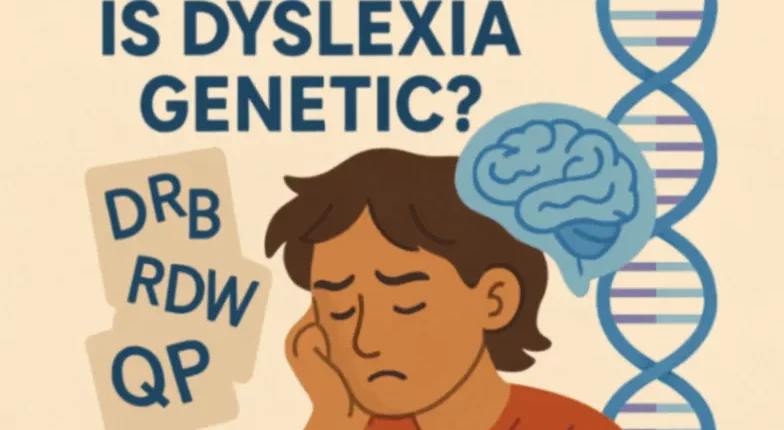Share this @internewscast.com
Have you ever seen your child having trouble reading and thought, “That was me at their age”? Maybe a sibling, parent, or cousin experienced similar challenges. It’s not just a coincidence—it might be something more significant. And that’s when the crucial question arises: Is dyslexia hereditary?
Dyslexia influences how the brain interprets written words. It’s unrelated to intelligence or effort. It’s about how the brain functions. Although science hasn’t pinpointed a single cause, research strongly suggests that dyslexia often runs in families.
If you’re questioning whether dyslexia can skip generations, how probable it is for your child to inherit it, or what signs to look for, you’re not alone. Families with a dyslexic history often encounter confusion, worry, and doubt. This blog breaks it all down with facts, expert opinions, and relatable examples—using language that’s straightforward, sincere, and supportive.
Is Dyslexia Genetic or Hereditary?
Research consistently shows that dyslexia is genetic. But it’s not as simple as passing one “dyslexia gene” from parent to child. Instead, it’s the result of multiple genes influencing how the brain processes language, reading, and writing.
Among children with a family history of dyslexia, around 45% show signs of dyslexia. That’s a pretty strong connection.
Studies also show:
-
If one parent has dyslexia → 50–60% chance the child will too
-
If both parents have it → the risk climbs even higher
-
If one sibling has dyslexia → 40% chance another will
Dr. Nelson Dorta explains that nearly 40% of siblings of dyslexic kids have reading struggles too. That tells us it’s more than a coincidence. The odds stack up across families.
These genes don’t directly cause dyslexia. Instead, they influence brain development, especially in areas responsible for reading and language. Combined with learning environments, they shape a child’s reading ability.
So yes, hereditary dyslexia is real. It’s not always predictable, but it often runs in families.
Does the Mother or the Father Pass on Dyslexia?
The short answer? Both can.
There’s no rule saying only moms or only dads pass on dyslexia. Either parent can pass on the set of genes that raise the risk. And because dyslexia is linked to many genes, it doesn’t follow the typical dominant or recessive patterns you might see in other genetic traits.
Some of the genes tied to dyslexia are found on the X chromosome. Women have two Xs, and men have one X and one Y. That helps explain why dyslexia is often found more in boys. If a boy inherits a dyslexia-linked X gene, he doesn’t have a second X to balance it out like girls do.
But don’t be fooled, girls can have dyslexia too, even if it’s diagnosed less often.
So, if you’re asking, how to know if dyslexia is inherited, the answer lies in your family history of dyslexia, not just in mom or dad’s DNA, but in patterns across the whole family tree.
Can Dyslexia Skip a Generation?
This is where things get tricky. Dyslexia doesn’t always follow clean family lines. It can show up in some members and not in others. One generation may have multiple people with dyslexia, while the next one might have none. Then, it pops up again later.
Here’s why: some people carry the genetic causes of dyslexia, but never show the symptoms. That’s called being a silent carrier. They may have a mild version, or maybe their environment helped them develop reading skills early. Either way, they can still pass the genes on.
That’s why family history of dyslexia is so important, even if your parents or grandparents didn’t struggle, the genes might still be there, waiting.
So yes, dyslexia can skip a generation, but it hasn’t disappeared. It’s just hiding in plain sight.
What Is the Likelihood of Someone Inheriting Dyslexia?
This depends on the family tree, but numbers don’t lie:
-
If one parent has dyslexia → 50% to 60% chance the child will too.
-
If both parents have it → risk climbs even higher.
-
Siblings? 40% chance if one child already has dyslexia.
In a well-known study, Dr. Beve Hornsby found that 88% of people with dyslexia had a close family member with the same issue. That includes siblings, parents, uncles, aunts, even grandparents.
Another study from the Dyslexia Research Trust looked at 400 families. They found strong links on chromosome 6 and chromosome 18. One key gene, KIAA0319, shows up again and again in dyslexic individuals. It’s believed to affect how the brain processes written language.
Let’s break down the genetic risk levels:
|
Family Member with Dyslexia |
Child’s Estimated Risk |
|
One parent |
50–60% |
|
Both parents |
70–100% |
|
Sibling |
40% |
|
Distant relative |
15–20% |
These numbers are not promises. But they tell us that dyslexia risk factors skyrocket when it runs in the family.
Is Dyslexia Dominant or Recessive?
Dyslexia doesn’t work like eye color or blood type. It’s not about one dominant gene overpowering a recessive one. It’s far more layered than that.
Think of it like this: imagine each gene is a knob on a control panel. Each knob turns up or down certain brain functions, memory, attention, visual processing, and language skills. When enough of these knobs are turned in a certain way, dyslexia can happen.
This is called a polygenic trait, meaning many genes work together. That’s why even people with the same diagnosis can show different symptoms. Some struggle with spelling. Others can’t decode words. A few might have trouble understanding what they read.
Bottom line: dyslexia is neither dominant nor recessive. It’s a team effort, genes, brain wiring, and environment all play a part.
Family History of Dyslexia
Let’s talk about why a family history of dyslexia matters so much. This is where most people find their answers, not in a lab, but in their own homes.
You may notice patterns. Maybe your father never liked reading. Maybe your aunt had spelling problems. Or your cousin has to read everything twice. These signs can point to inherited learning disabilities.
The more family members with dyslexia, the more likely it is to show up in the next generation.
Some early signs of dyslexia in children include:
If you’re seeing this in your child, and there’s a history of dyslexia in your family, it’s time to consider early help.
And if you’re unsure, genetic testing for dyslexia exists, but it’s still in early stages. Right now, family patterns tell us more than any single test can.
Techniques That Help With Early Intervention
The earlier dyslexia is caught, the better the outcomes. That’s why understanding dyslexia diagnosis in families is so important.
These are a few approaches used when working with at-risk children:
-
Orton-Gillingham Approach
Uses multisensory, structured techniques to teach reading and spelling.
-
Lindamood-Bell Method
Focuses on creating images for sounds and words, strengthening reading comprehension.
-
Wilson Reading System
Geared for students who need a more intensive phonics-based program.
-
Barton Reading and Spelling System
One-on-one, phonemic awareness building, often used at home.
Start these strategies early. Don’t wait for a full diagnosis; if the signs are there and the family history of dyslexia is strong, begin support.
Conclusion
So, is dyslexia genetic? In most cases, yes. It often runs in families, carried quietly from one generation to the next.
Whether you’re a parent watching your child struggle or an adult who’s always found reading hard, knowing your family history of dyslexia is key. It helps you spot patterns, take action early, and choose the right support.
Dyslexia doesn’t mean someone isn’t smart. It means they learn differently. With the right tools and early help, dyslexic individuals can thrive at school, at work, and in life.
And remember, if you’re still unsure, take a dyslexia test to explore your traits. It’s not a diagnosis, but it can be a first step toward understanding and supporting the way your brain works.














